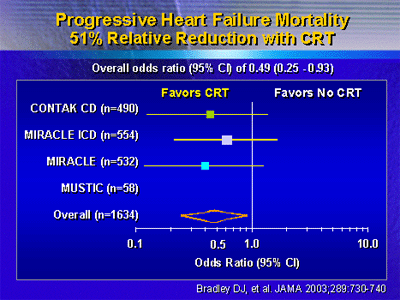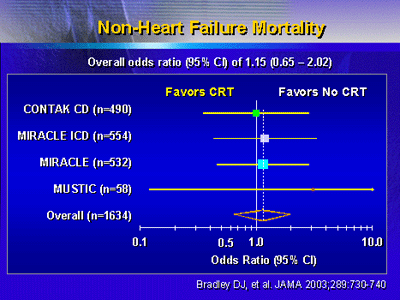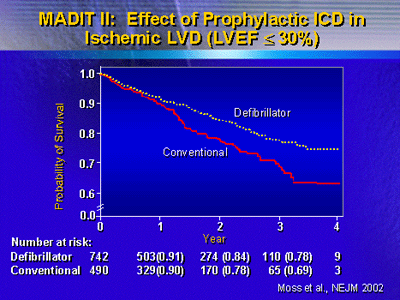Dr. Abraham
argued that all patients that receive cardiac resynchronization
therapy (CRT) should also receive an implantable cardioverter
defibrillator (ICD). This will optimally improve outcomes in
left ventricular dysfunction or heart failure.
A primary goal in the treatment of heart failure is to extend
the life of the patient. Patients with left ventricular dysfunction,
with or without the clinical signs and symptoms of heart failure,
usually die as a consequence of either progressive heart failure
(progressive pump dysfunction) or sudden cardiac death (usually
a ventricular arrythmia).
To optimize outcomes in left ventricular dysfunction or
heart failure, cardiologists must reduce both morbidity and
mortality related to both causes of death. Clinical trial
data show that cardiac resynchronization therapy (CRT) can
confer a survival benefit. However, the weight of evidence
suggests that CRT reduces mortality related to progressive
pump failure, but not sudden cardiac death.
Clinical trials of resynchronization therapy have evaluated
a variety of measures, including quality of life, functional
status and exercise capacity, remodeling parameters, and morbidity
and mortality.
In more than 12 trials including a total of more than 4,000
patients CRT consistently improves quality of life and functional
status. The concordance of the data is striking, with marked
improvements in the Minnesota Living with Heart Failure quality
of life score, and significant improvements in New York Heart
Association functional class. This is also true for the effect
of CRT on exercise capacity. Investigations show a consistent
pattern of improvement in peak VO2 and exercise
capacity.
Furthermore, CRT appears to have an effect on the natural
history of disease. Dr. Abraham and colleagues recently published
results of the Multicenter InSync Randomized Clinical Evaluation
(MIRACLE) trial. While they powered the study to evaluate
functional endpoints, the researchers did show that CRT improved
measures of heart failure morbidity, and in the combined endpoint
of death or worsening heart failure requiring hospitalization.
However, these results do not tell the entire story. A recently
published meta-analysis extends the observations of the MIRACLE
trial. Researchers demonstrated a 51% reduction in the risk
of death due to progressive heart failure. However, they found
that CRT did not reduce mortality unrelated to heart failure.
In fact, they found a trend toward increased mortality. Dr.
Abraham said this shows that the gains occurred in reductions
on heart failure mortality, but not sudden cardiac death.


There are now numerous trials on the use of ICDs in patients
with left ventricular dysfunction or heart failure. Predominantly,
these trials include patients with ischemic heart disease.
The exclusion of patients with nonischemic cardiomyopathy
is a limitation. However, Dr. Abraham argued that there are
now compelling data in both groups of patients that combined
CRT and ICD is beneficial for both groups.
The landmark Multicenter Automatic Defibrillator Implantation
Trial-II (MADIT II) trial may be the paradigm for use of prophylactic
ICDs in patients with left ventricular dysfunction or heart
failure. In patients with ischemic heart failure, and left
ventricular ejection fraction less than or equal to 30%, there
was a reduction in all-cause mortality of approximately 31%.
Dr. Abraham said these study results are very good news for
patients.

All subgroups in MADIT II benefited equally well from the
ICD. Notably, subgroup analysis suggested that patients with
wider QRS complexes had greater benefit.
However, ICDs primarily reduce mortality due to sudden cardiac
death, Dr. Abraham said. They do not appear to alter the natural
history of heart failure or reduce mortality due to progressive
heart failure. In fact, MADIT II results show that the incidence
of new onset or worsening heart failure was somewhat higher
in the ICD group versus the group of patients that received
conventional therapy.
With these findings, it becomes apparent that physicians
can optimize outcomes in left ventricular dysfunction and
heart failure with combined use of CRT and ICD. In fact, new
data at ACC provides further support for this argument. In
the COMPANION
trial, more than 1,600 patients received medical therapy
alone, CRT, or CRT plus ICD. There was a highly significant
43% reduction in all-cause mortality in the group of patients
that received both CRT and ICD. In contrast, there was a non-significant
24% reduction in all cause mortality in the group that received
CRT only.
|